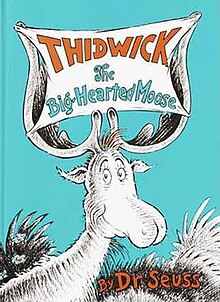
Theodor Seuss Geisel was an American children's author and cartoonist. He is known for his work writing and illustrating more than 60 books under the pen name Dr. Seuss. His work includes many of the most popular children's books of all time, selling over 600 million copies and being translated into more than 20 languages by the time of his death.

The moose or elk is the world's tallest, largest and heaviest extant species of deer and the only species in the genus Alces. It is also the tallest, and the second-largest, land animal in North America, falling short only of the American bison in body mass. Most adult male moose have broad, palmate antlers; other members of the deer family have antlers with a dendritic ("twig-like"), pointed configuration. Moose inhabit the circumpolar boreal forests or temperate broadleaf and mixed forests of the Northern Hemisphere, thriving in cooler, temperate areas as well as subarctic climates.

The Wuzzles is an American short-lived animated television series created by Fred Wolf and produced by Disney Television Animation in their first of two productions. The series was broadcast from September 14 to December 7, 1985 on CBS. An idea pitched by Michael Eisner for his new Disney television animation studio, the premise is that the main characters are hybrids of two different animals. The series ran for one season of 13 episodes.
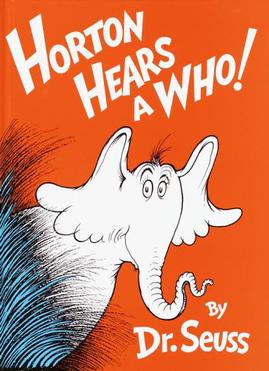
Horton Hears a Who! is a children's book written and illustrated by Theodor Seuss Geisel under the pen name Dr. Seuss. It was published in 1954 by Random House. This book tells the story of Horton the Elephant and his adventures saving Whoville, a tiny planet located on a speck of dust, from the animals who mock him. These animals attempt to steal and burn the speck of dust, so Horton goes to great lengths to save Whoville from being incinerated.

Horton Hatches the Egg is a children's book written and illustrated by Theodor Geisel under the pen name Dr. Seuss and published in 1940 by Random House. The book tells the story of Horton the Elephant, who is tricked into sitting on a bird's egg while its mother, Mayzie, takes a permanent vacation to Palm Beach. Horton endures a number of hardships but persists, often stating, "I meant what I said, and I said what I meant. An elephant's faithful, one hundred percent!" Ultimately, the egg hatches, revealing an elephant-bird, a creature with a blend of Mayzie's and Horton's features.

The Wubbulous World of Dr. Seuss is an American children's puppet television series based on characters created by Dr. Seuss, produced by The Jim Henson Company. It aired from October 13, 1996, to May 15, 1998, on Nickelodeon. It combines live puppets with digitally animated backgrounds, and in its first season, refashioning characters and themes from the original Dr. Seuss books into new stories that often retained much of the flavor of Dr. Seuss' own works.

Marvin Elliott Miller was an American actor. Possessing a deep baritone voice, he began his career in radio in St. Louis, Missouri before becoming a Hollywood actor. He is remembered for voicing Robby the Robot in the science fiction film Forbidden Planet (1956), a role he reprised in the lesser-known The Invisible Boy (1957).

The Grinch is a fictional character created by children's author and cartoonist Dr. Seuss. He is best known as the main character of the 1957 children's book How the Grinch Stole Christmas! He has been portrayed and voiced by many actors, including Boris Karloff, Hans Conried, Bob Holt, Walter Matthau, Anthony Asbury, Jim Carrey, Rik Mayall, Benedict Cumberbatch, Matthew Morrison, David Howard Thornton, and James Austin Johnson.

"Homer vs. Patty and Selma" is the seventeenth episode of the sixth season of the American animated television series The Simpsons. It originally aired on the Fox network in the United States on February 26, 1995. In the episode, Homer loses all his money in pumpkin futures and must turn to Patty and Selma for a loan. Meanwhile, Bart takes up ballet lessons, with an instructor voiced by actress Susan Sarandon.
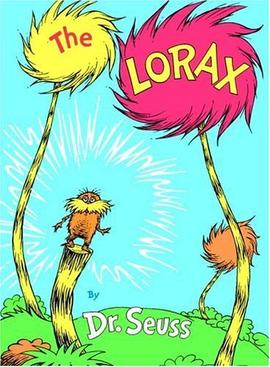
The Lorax is a children's book written by Dr. Seuss and published in 1971. It chronicles the plight of the environment and the Lorax, the main character, who "speaks for the trees" and confronts the Once-ler, a business magnate who causes environmental destruction.

Moose Hunters is a 1937 American animated short film produced by Walt Disney Productions and released by United Artists. It was the 93rd short in the Mickey Mouse film series, and the fourth for that year. The cartoon stars Mickey Mouse, Donald Duck, and Goofy on a moose hunting expedition. It was directed by Ben Sharpsteen and features music by Paul J. Smith. The voice cast includes Walt Disney as Mickey, Clarence Nash as Donald, and Pinto Colvig as Goofy.

How the Grinch Stole Christmas is a 2000 American Christmas fantasy comedy film directed by Ron Howard, who also produced with Brian Grazer, from a screenplay written by Jeffrey Price and Peter S. Seaman. The film was based on Dr. Seuss's 1957 children's book of the same name, as the first Dr. Seuss book to be adapted into a full-length feature film and the first of only two live-action Dr. Seuss films, followed by The Cat in the Hat released in 2003. This was also the second adaptation of the book, after the 1966 animated TV special of the same name.

Horton Hears a Who! is a 2008 American animated adventure comedy film based on the 1954 book of the same name by Dr. Seuss, produced by Blue Sky Studios and distributed by 20th Century Fox. The film was directed by Jimmy Hayward and Steve Martino, from a screenplay written by the writing team of Cinco Paul and Ken Daurio. It stars the voices of Jim Carrey and Steve Carell as Horton the Elephant and Mayor Ned McDodd, respectively, alongside Carol Burnett, Will Arnett, Seth Rogen, Dan Fogler, Isla Fisher, Jonah Hill, and Amy Poehler. Recurring Blue Sky collaborator John Powell composed the film's musical score. It is the fourth screen adaptation of the book following the 1970 Chuck Jones television special, the 1987 Soviet animated short, and the 1992 Russian animated short.

Open Season is a 2006 American animated adventure comedy film produced by Sony Pictures Animation as its debut film. It was directed by Roger Allers and Jill Culton and co-directed by Anthony Stacchi, from a screenplay by Nat Mauldin and the writing team of Steve Bencich and Ron J. Friedman, and a screen story by Culton and Stacchi, based on an original idea by Steve Moore and John B. Carls. The film stars the voices of Martin Lawrence, Ashton Kutcher, Gary Sinise, and Debra Messing, with Billy Connolly, Jon Favreau, Georgia Engel, Jane Krakowski, Gordon Tootoosis, and Patrick Warburton in supporting roles. Its plot follows Boog, a domesticated grizzly bear, who teams up with a one-antlered mule deer named Elliot and other woodland animals to defeat human hunters.
Welcome is a 1986 Soviet paint-on-glass-animated 10-minute film adapted from the 1948 children's book by Dr. Seuss Thidwick the Big-Hearted Moose. It is a coproduction of Sverdlovsk television studio and Gosteleradio.

Horton the Elephant is a fictional character from the 1940 book Horton Hatches the Egg and 1954 book Horton Hears a Who!, both by Dr. Seuss. He is also featured in the short story Horton and the Kwuggerbug, first published for Redbook in 1951 and later rediscovered by Charles D. Cohen and published in the 2014 anthology Horton and the Kwuggerbug and More Lost Stories. In all books and other media, Horton is characterized as a kind, sweet-natured, and naïve elephant who manages to overcome hardships.
Horton Hears a Who! is a 1970 American animated television special based on the 1954 Dr. Seuss book of the same name, Horton Hears a Who! It was produced and directed by Chuck Jones who previously produced the Seuss special How the Grinch Stole Christmas! for MGM Television and first broadcast March 19, 1970 on CBS. The special contains songs with lyrics by Seuss and music by Eugene Poddany, who previously wrote songs for Seuss' book, The Cat in the Hat Song Book.
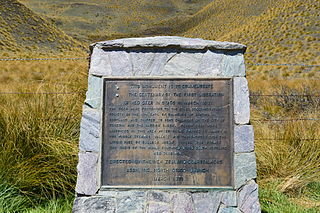
Hunting is a popular recreational pursuit and a tourist activity in New Zealand with numerous books and magazines published on the topic. Unlike most other developed countries with a hunting tradition, there are no bag-limits or seasons for hunting large game in New Zealand. Hunting in national parks is a permitted activity. The wide variety of game animals and the limited restrictions means hunting is a popular pastime which has resulted in a high level of firearms ownership among civilians.
Theodor Seuss Geisel, better known as Dr. Seuss, published over 60 children's books over the course of his long career. Though most were published under his well-known pseudonym, Dr. Seuss, he also authored a certain amount of books as Theo. LeSieg and one as Rosetta Stone.
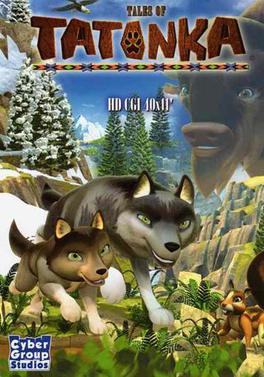
Tales of Tatonka is a French computer-animated cartoon series produced by Cyber Group Studios and broadcasters TiJi and RAI in 2010.
